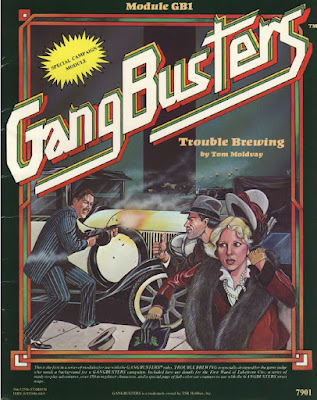Retrospective: Trouble Brewing
 Gangbusters was a favorite RPG of mine in my youth, but I've long had the impression that not a lot of people took notice of it when it was released. That's too bad, because, in addition to its original boxed set being terrific on its own, TSR published a number of truly superb follow-up products to support it, most of them adventure scenarios. The one that wasn't was 1982's Trouble Brewing, written by none other than Tom Moldvay and, much like
Murder in Harmony
by Mark Acres, it made a lasting impression on me.
Gangbusters was a favorite RPG of mine in my youth, but I've long had the impression that not a lot of people took notice of it when it was released. That's too bad, because, in addition to its original boxed set being terrific on its own, TSR published a number of truly superb follow-up products to support it, most of them adventure scenarios. The one that wasn't was 1982's Trouble Brewing, written by none other than Tom Moldvay and, much like
Murder in Harmony
by Mark Acres, it made a lasting impression on me.Trouble Brewing bills itself as a "special campaign supplement" and that's a very apt description, as we'll see. Like most TSR modules of its era, this one is a 32-page staple-bound booklet wrapped in a removable, four-sided, cardboard cover. Both the booklet and the cover are memorably illustrated by the late, great Jim Holloway, whose combination of realism and humor seems perfect for the module's subject matter. Jeff Easley also contributes a couple of pieces, but they are, sadly, not nearly so memorable. Oddly, the back panel of the cover features a collection of cut-out cars, trucks, and other vehicles for use with the street map included in the original boxed set. I never understood why TSR did this, since cutting up the cover is a poor option and, being color, the counters didn't photocopy well, given the technology of the era.
The bulk of the booklet consists of information on Lakefront City – the game's ersatz Chicago – and its most important inhabitants, complete with game statistics. While this might seem dull, it's not. Moldvay does a great job in giving all the characters, from the heads of the important criminal gangs to the local government and law enforcement right down to butchers and hardware store owners, a degree of individuality that's very helpful to a referee. Many of them even includes small details that could easily be turned to the creation of scenarios, like the fact that the widowed jeweler Saul Goldstein has secretly left his business to his employee, Fred Russell, in his will or that one of the waitresses at Velma's Restaurant is secretly the daughter of the second in command of the O'Connor Gang. Little of it is earthshattering or even particularly imaginative but it's helpful, especially to inexperienced referees looking to instill some life into their campaigns.
Another aspect of this section of the booklet that's worth pointing out is the fact that a great many of the character descriptions are of "average" citizens of Lakefront City rather than of "important" people, such as politicians or gangsters. This is very helpful in my experience, since it not only helps bring the setting to life but also gives the referee the tools he needs in the event the player characters wander into a barber shop or five-in-dime store unconnected with the current scenario. As someone who has struggled such matters in urban adventures, I recognize the value in books like this.
In addition to the details of Lakefront City itself, Trouble Brewing also includes an extensive campaign outline. This outline consists of a variety of scenarios intended for use with different types of characters, such as gangsters, law enforcement, even investigative reporters. Though each scenario can be played on its own, each forms part of a larger campaign scenario that deals with the brewing turf war between Al Tolino and Deanie O'Connor, as they vie with one another for control of the city's lucrative criminal enterprises. This is very useful to the referee on many levels, not least being that it affords players the opportunity to play out this campaign from a variety of different angles. This flexibility and open-endedness is to be commended in my opinion. I know I learned a lot from its presentation in my youth.
If I have a criticism of Trouble Brewing, it's that it's set in a fictional city rather than a real world one, but I fully understand why this was done. When I was younger, this bothered me a great deal, as I wanted to learn more about, say, Chicago or New York's gang wars during the 1920s. The advantage of a fictional locale is that there's no need for a great deal of research, nor is there any expectation that events will unfold just as they did in our world. Still, my preference, then and now, is for real history over imaginary history and it's one of the few qualms I have about what is otherwise a very well done and useful module for use with Gangbusters.
James Maliszewski's Blog
- James Maliszewski's profile
- 3 followers



